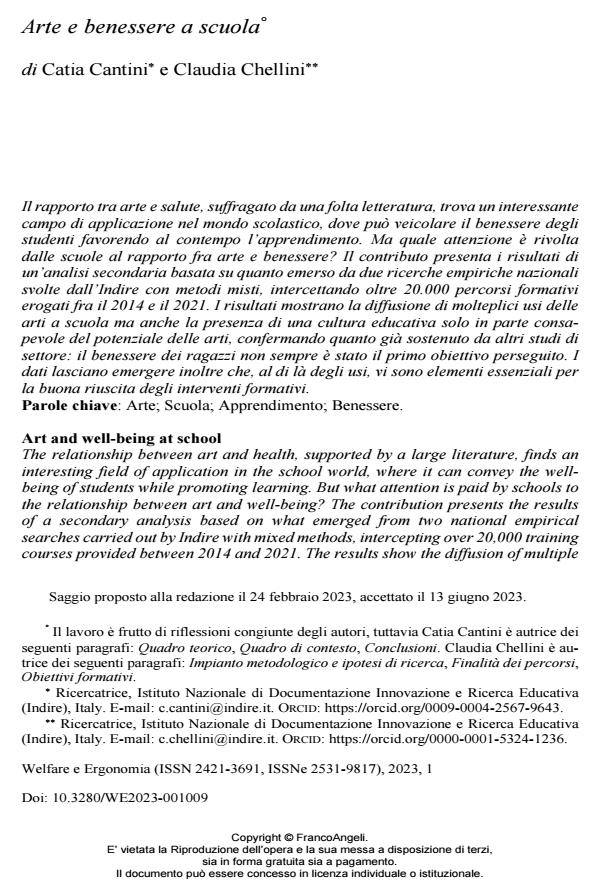Art and well-being at school
Journal title WELFARE E ERGONOMIA
Author/s Catia Cantini, Claudia Chellini
Publishing Year 2023 Issue 2023/1 Language Italian
Pages 11 P. 109-119 File size 242 KB
DOI 10.3280/WE2023-001009
DOI is like a bar code for intellectual property: to have more infomation
click here
Below, you can see the article first page
If you want to buy this article in PDF format, you can do it, following the instructions to buy download credits

FrancoAngeli is member of Publishers International Linking Association, Inc (PILA), a not-for-profit association which run the CrossRef service enabling links to and from online scholarly content.
The relationship between art and health, supported by a large literature, finds an interesting field of application in the school world, where it can convey the well-being of students while promoting learning. But what attention is paid by schools to the relationship between art and well-being? The contribution presents the results of a secondary analysis based on what emerged from two national empirical searches carried out by Indire with mixed methods, intercepting over 20,000 training courses provided between 2014 and 2021. The results show the diffusion of multiple uses of the arts at school but also the presence of an educational culture that is only partially aware of the potential of the arts, confirming what has already been claimed by other studies in the sector: the well-being of children has not always been the first objective pursued. The data also reveal that, beyond the uses, there are essential elements for the success of the training interventions.
Keywords: Art; School; Learning; Well-being.
- Adorno T.W. (1962). Introduzione alla sociologia della musica. Torino: Einaudi.
- Bamford A. (2006). The Wow Factor: Global Research Compendium on the Impact of the Arts in Education. Berlin: Waxmann Verlag.
- Bruner J. (1996). The Culture of Education. Cambridge, MA: HUP.
- Cantini C., Chellini C., Pappalardo V. e Ponzio S.M. (2022). Io sono meraviglia. La didattica delle arti nel PON FSE 2014-2020. Per uno studio sull’educazione all’arte: del teatro, della musica, del pensiero. Firenze: Indire. -- Testo disponibile al sito: https://pon20142020.indire.it/portale/wp-content/uploads/2022/10/Io-sono-meraviglia.-La-didattica-delle-arti-nel-PON-FSE-2014-2020.-Per-uno-studio-sulleducazione-allarte-del-teatro-della-musica-del-pensiero_DEF.pdf.
- Cantini C. and Morandi M. (2022). La musica unisce la scuola: una rassegna fra tradizione e innovazione, DigitCult @Scientific Journal on Digital Cultures, 2. -- Testo disponibile al sito: https://digitcult.lim.di.unimi.it/index.php/dc.
- Chellini C., Pizzigoni F.D., Rosa A. e Taddeo G. (2020). Piano delle Arti - Misure e) ed f). Rapporto di monitoraggio. Firenze: Indire. -- Testo disponibile al sito: https://pianodellearti.indire.it/monitoraggio/docs/2021_RAPPORTO_DI_MONITORAGGIO_Seconda%20annualita_luglio_2022.pdf.
- Dallari M. (2021). La zattera della bellezza. Per traghettare il principio di piacere nell’avventura educativa. Trento: Il Margine.
- Dallari M. (2005). La dimensione estetica della paideia. Fenomenologia, arte, narratività. Trento: Erickson.
- Dallari M. e Francucci C. (1998). L’esperienza pedagogica dell’arte. Scandicci: La Nuova Italia.
- Damasio A. (1994). Descartes’ Error. NYC: Putnam.
- Decreto Legislativo 13 aprile 2017, n. 60.
- Dewey J. (1934). Art as Experience. New York: Minton, Balch and Company.
- EU (2021). Regulation 2021/818 of the European Parliament and of the Council establishing the Creative Europe Programme (2021 to 2027).
- EU (2018a). Council Recommendation on key competences for lifelong learning, 2018/C 189/01.
- EU (2018b). Parliament resolution on the New European Agenda for Culture, (2018/2091 (INI)).
- EU (2009). Parliament resolution on artistic studies in the EUs, (2008/2226(INI)).
- Gardner H. (1983). Frames of Mind: The Theory of Multiple Intelligences. NYC: Basic Books.
- Goddard C. and Wierzbicka A. (2014). Words and Meanings. Lexical Semantics Across Domains, Languages and Cultures. London: Oxford University Press.
- Goleman D. (1995). Emotional intelligence. NYC: Bantam Books.
- Istat (2022). BES 2021. Il benessere equo e sostenibile in Italia. Roma: Istat, -- https://www.istat.it/it/archivio/269316.
- Jin X. and Ye Y (2022). Impact of fine arts education on psychological wellbeing of higher education students through moderating role of creativity and self-efficacy. Front. Psychol., 13.
- Lucangeli D. (2020). Cinque lezioni leggere sull'emozione di apprendere. Trento: Erickson.
- Marini A. (2018). Manuale di neurolinguistica. Fondamenti teorici, tecniche di indagine, applicazioni. Roma: Carocci.
- Morin E. (2002). L’identità umana. Milano: Raffaello Cortina Editore.
- OECD (2019). PISA 2018 Results (Volume III): What School Life Means for Students’ Lives. Paris: PISA, OECD Publishing.
- Polàcek K. (2005). Questionario sui Processi di Apprendimento. Firenze: Organizzazioni Speciali.
- Roege G.B. and Kim K.H. (2013). Why we need arts education. Empirical Studies of the Arts, 31: 121-130.
- Sellman E. and Cunliffe A. (2012) Working with artists to promote mental health and well-being in schools – an evaluation of processes and outcomes at four schools. In: Stickley, T., editor, Qualitative Research in Arts and Mental Health: Contexts, meanings and evidence. Monmouth: PCCS Books, 140-169.
- Siddins E. (2021). Transforming visual art education to benefit students’ wellbeing. NiTRO, 38.
- Snyder K.M. and Cooper K. (2015). Innovating schools through dialogic arts-based practice: ingredients for engaging students with a whole new mind. Journal for Learning through the Arts, 1: 1-20. DOI: 10.21977/D911112693
- WHO (2019). Health Evidence Network Synthesis. Report 67. -- Testo disponibile al sito: https://apps.who.int/iris/bitstream/handle/10665/329834/9789289054553-eng.pdf.
Catia Cantini, Claudia Chellini, Arte e benessere a scuola in "WELFARE E ERGONOMIA" 1/2023, pp 109-119, DOI: 10.3280/WE2023-001009